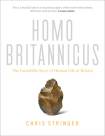Homo Britannicus: The Incredible Story of Human Life in Britain

Chris Stringer
Published by: Allen Lane
Publication date: 2006
ISBN: 978-0-713-99795-8 (hbk)
List price: £25.00
320 pp
www.penguin.com
For most of us, the history of the human occupation of Britain is probably a little vague. There were old, middle and new Stone Age people around for thousands of years, then Bronze Age, then Iron Age, and finally the Romans came and sorted us out. We might also have faint memories of controversies over ‘eoliths’, bits of flint from the Thames gravels that might be tools, or might be nothing at all, Piltdown Man and some other hominid skulls and skeletons found 100 years ago, and of uncertain age.
Everything has now changed, and rather rapidly. Re-excavations of older sites in the 1970s and 1980s and the discovery of the Boxgrove site in the 1980s, showed that human occupation of Britain extended back further than had been thought. And perhaps the major change has been the improvement of time scales. The old four- or five-division ice age that was used by earlier palaeontologists and archaeologists has given way to a much more complex, and well-dated, picture of numerous ice advances and retreats. Individual sites can be placed quite accurately in the chronology based on fossil evidence (beetles, pollen, small mammals) and isotope evidence (classic carbon dating, and newer methods such as uranium-series dating). The fossils and isotopes can also give considerable detail on climatic conditions at each site.
The application of new methods, and growing interdisciplinary work, was recognised in 2001 by the award of perhaps the largest grant ever given to an archaeological project, over one million pounds, awarded to the Ancient Human Occupation of Britain (AHOB) project, led by Chris Stringer at the Natural History Museum. This book is a remarkable final report of the AHOB project, which finished in 2006 (and subsequently extended to 2010 by renewal of funding). The team of 13 scientists, as well as 16 associates, has produced 150 scientific papers, and further excavation, dating, and DNA extraction from fossil bones is promised.
The headline discoveries by the AHOB team were that humans first occupied Britain 650,000 years ago, as shown by finds of tools at the Pakefield site in Suffolk, and that human occupation of Britain was not continuous after that time – there were numerous retreats and reinvasions.
Chris Stringer’s book deserves its considerable success so far. The book is written in a very personal style, as well it should be, since Chris has been instrumental in driving the blossoming of new work and the new understanding. He presents enough of the mud and sweat and intense concentration required to excavate, as well as the way in which earth scientists and archaeologists have worked together. I particularly like the detailed essays by 14 of the scientists in the AHOB team about their backgrounds and their work. The illustrations are superb – marvellous maps of the geography of southern Britain at different points through the Pleistocene and Holocene, useful time charts, and spectacular photographs of sites and specimens. Some photographs - of African savannas, people on the beach, forests, meandering rivers - while beautiful, are perhaps less essential.
Mike Benton, Department of Earth Sciences, University of Bristol